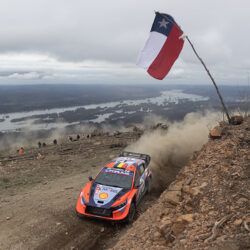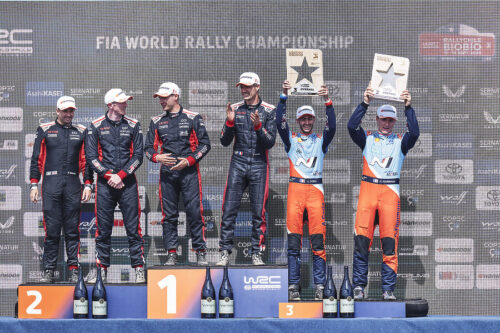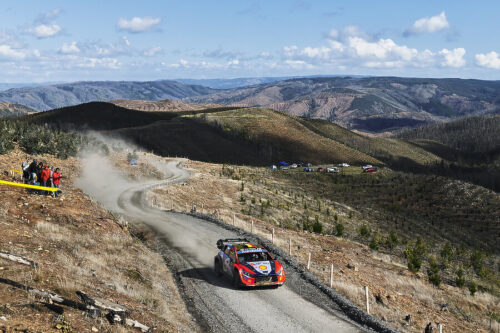Recce Updates McKlein’s Rally Tips have now been updated after our rally recce. You will be able to find the latest insights highlighted, to give you the most up-to-date overview for this rally.
Rally Argentina is huge, it’s one of the biggest spectator events held in the country. As a long-term permanent fixture on the WRC calendar, Rally Argentina is steeped in history and since finding it’s home near the city of Cordoba it has changed little in the last 20 years. The actual base for this event is Villa Carlos Paz; a curious small holiday town surrounding a massive lake around 30 minutes drive from Cordoba. The mountains lie north, south and west of Carlos Paz and it is in these hills where the stages are found.
Some of the main characteristics of the rally are the numerous river crossings and water-splashes and some soft sandy gravel roads, which become very rutted for the second pass. The wider 2017 spec WRC cars will find these ruts a bigger challenge than in previous years. Changeable autumn weather can be a major factor in the rally as quite often the stages at higher altitude are shrouded in thick fog.

First time overseas visitors to Rally Argentina will experience something completely different compared with any European rally, it’s quite wild and rugged out in the pampas and up in the hills. You will never be alone on this event, there are 1,000s of spectators absolutely everywhere and they are some of the most welcoming and hospitable in the world. The hills are alive with the buzz of conversation, smoke from open fires fills the air and the smell of barbequing meat is ever present. You will almost certainly be invited to sample some food, it’s all part of the Argentina experience.
To get to this rally you should fly into Cordoba International airport and collect a rental car. Pay attention to the car you get, check it thoroughly, in particular the spare wheel. You need to pack clothing for more-or-less all seasons; it can be mild sunshine one day and freezing cold, or wet, the next. The Sunday stages are held at high altitude close to 2,000 metres and in recent years snow has fallen on these stages.
One thing everybody (except maybe vegetarians) enjoys in Argentina is the food and drink, in particular beefsteaks and red Malbec wine. You really can’t go wrong for eating out in Villa Carlos Paz, the town is full of restaurants however you need to be aware that Argentineans tend to eat dinner very late and some places do not open until 2100.

Day 1
Shakedown: Villa Carlos Paz-Cabalango 6km
You can park at the start of the shakedown and then walk in a few hundred metres where the road is quite fast. After about 2.5km from the start there is an access road coming in from the southwest but the junction itself is not much more than a T-junction right. Best viewing is from the end of the stage where a few sweeping bends downhill can be seen and there is organised parking too. Walk a few hundred metres into the stage through the fields and bushes and you have various choices.
Food and drink:
As you can expect a lot of spectators on shakedown its best to top up in Villa Carlos Paz beforehand and bring your own food for the morning, as the few local stands on the spot might be too crowded. Any 24h-fuel station in town does the job.
SSS1: Ciudad de Corbody Super Special Stage 1.75km
The city stage in Cordoba is run at night and as you might expect it can be a bit of a parking and traffic nightmare. The rally cars will be sliding on their gravel tyres on tarmac and circle a few roundabouts, but if you do not have a VIP ticket you might see little for a lot of effort. One highlight is where they fly over an artificial jump on a spectacularly illuminated bridge. The stage is a modified version from last year and now incorporates a gravel section close to the main spectator points and grandstands.

Day 2
This is quite a long day to the south with two identical loops over three stages, with a few hours time in between each loop for a nice lunch. The best viewing places are in the valley of Santa Rosa de Calamuchita with stages on both sides. If you do travel from Cordoba and the north you must go early and arrive in the stage well before 0700am, otherwise there is too much slow traffic tackling the very twisty section along a lake before you reach Villa La Merced. This day is also usually the warmest and sunniest of the event as it is outside the higher mountain ranges.
SS2/6: San Agustin-Villa General Belgrano 19.51km
This stage is an old classic but not used in recent years. The road climbs after a very fast start through some hills before descending down to the finish with some interesting bends although in a forest. It does not have any access, so lock-in and camping would be the only real option. At the time of writing there were some discussions about this stage being shortened by eliminating the first five kilometres, as it is considered too fast and rough. If this does indeed happen then there will be a fantastic open hairpin right approximately two kilometres from the stage start. If you walk in from the finish there are some great places to see the cars in full-speed action downhill. You just have to pick your favourite spot.
SS3/7: Amboy-Santa Monica 20.44km
Mainly run in a very flat area, this stage is normally the fastest on the rally. Its traditional highlight is at the finish with organised parking and partying, and easy viewing as the cars tackle two jumps. Popular with the photographers, these are the images seen for decades in all magazines. Some years ago also here through strong wind and BBQ fires the grass caught alight in the main parking and a lot of cars set on fire.

SS4/8: Santa Rosa-San Agustin 23.85km
Just 600 metres after the start the cars tackle a fast river crossing where you have easy access and parking adjacent to the start. Update: there is very little water in the river crossing. Apart from that this is the ideal stage for a lock-in day. With more rivers at 1.4km, 12.3km as well as 15.1km there are many open spaces for camping, watching the two passages and enjoy the day and the locals’ enthusiasm.
SS5/9: Parque Tematico 6km
In case you do not drive down to the south the only chance to see the cars in action is at the super stage in Villa Carlos Paz. Great viewing from up on the surrounding hills down to the track, an artificial watersplash and a nice jump too. And it’s run twice, once in a day and the second time at night.
Food and drink:
The valley of Santa Rosa de Calamuchita offers everything, as it is one of the main tourist regions in Argentina, part of it even resembles a traditional Austrian/German Alpine village.

Day 3
A difficult day to see much, if you want to take it easy go for stage 10/13, if it’s a sunny day and you love the wilderness stage 11/14 is a must for you.
SS10/13: Tanti-Villa Bustos 20.7km
Starting with plenty of corners in a hilly area this stage opens up soon to be quite fast in a fairly flat countryside and this stage has three little river crossings and lots of space to park up and stay for the rest of the day. It is run opposite to last year and at 16km there is an access road coming in from the north and Cosquin. But this is only a narrow T-junction on the stage, with little interest.

SS11/14: Los Gigantes-Cantera El Condor 38.68km
The first 15km of this stage are a photographer’s paradise, if it is a sunny day. Climbing up to almost 2,000 metres it has a backdrop of scenic mountains at their best. You can walk in from the start but it gets much better from 3km onwards. Once you reach 15km the scenery diminishes though and in 2016 this section was closed to all anyway, except the rally cars. There is only one access road coming in from the west, which works well and brings you to a nice location but it’s a very, very long detour back to civilisation.
SS12/15: Boca del Arroyo-Bajo del Pungo 20.52km
Apart from a nice river crossing one kilometre after the start here you are really in no-man’s land with little to do and to see surrounded by pampas bush land.
Food and Drink:
Take care of yourself. Once you leave the main road and main valley from Carlos Paz or Cosquin there is little, and beyond Tanti nothing at all. So bring what you need.

Day 4
The Sunday stages on Rally Argentina have remained the same for many years and they feature two absolute classics in WRC. You have the chance to see the cars in amazing open landscapes at high altitude and on a clear day you will see for miles and come away with a lasting impression of everything that is great about Rally Argentina.
Update: Monday’s official recce of the two Sunday stages had to be halted because of snow. The main road from Villa Carlos Paz to Mina Clavero was closed for a lengthy period by the police because conditions were deemed unsuitable for driving. Sunshine and clear skies are forecast from Wednesday through to Sunday so there will be no snow to be seen when the rally uses these roads in competition.
SS16/18 (Power Stage): El Condor – Copina 16.32km
El Condor is the iconic daddy of all scenic stages in WRC. The start is quite close to the main road, from which you can park approximately 1km before the cars turn off to go to the stage start. Walk directly across the pampas (you will see hundreds of spectators doing this) to reach the early part of the stage. This section, like most of the stage, is very technical, winding its way through huge rock outcrops and small hills. The best place to stand is on top of one of the big rocks, you could even move around between cars for a variation of views.
After 5km the stage changes slightly in nature as it plunges downhill into the valley. Towards the finish the cars cross several old stone and steel-roped cantilever bridges in the road. These have become iconic symbols of the stage and are well worth the effort to go and see.
There are absolutely no access roads into this stage, so if you wish to see anything after the first 3km then you must lock-in with your car (along with several 1,000 other fans). Leaving the stage in the traffic queue could take several hours, but it could be worth it!

SS17: Mina Clavero – Giulio Cesare 22.64km
More commonly known as Giulio Cesare, this is another classic stage of Rally Argentina and one of the WRC photographers’ favourite. You will have no doubt seen the images of the cars traversing a vast open rocky ‘moonscape’ before making some tight turns below steep rocks full of people. This all happens right at the end of the stage and it is here where McKlein would recommend you go. There is virtually no access worth using elsewhere and the climb up from the start of Mina Clavero on a rough narrow road is not that interesting. You have easy parking on the main road near to the stage finish, you can even see across the ‘moonscape’ from the main road. The best places to spectate are closer to action however, on top of the rocks overlooking the final corners of the stage. Be aware that the stage finish is at an altitude of around 2,000 metres and it is here that snow has been seen in recent years on the rally.
Food and drink:
Once you have left either Carlos Paz or Cordoba you are in total wilderness, with nothing to buy anywhere near the stages. Take what you need with you.
-01.png)
















